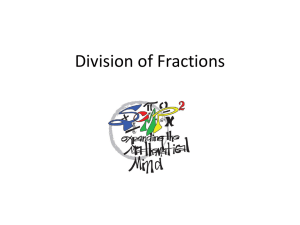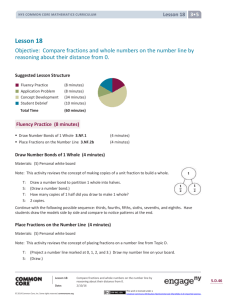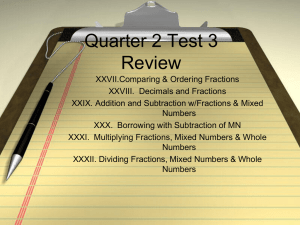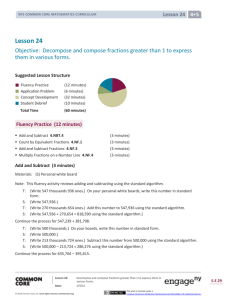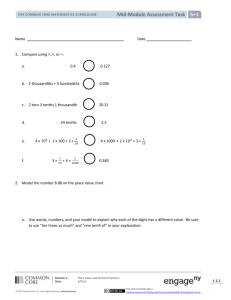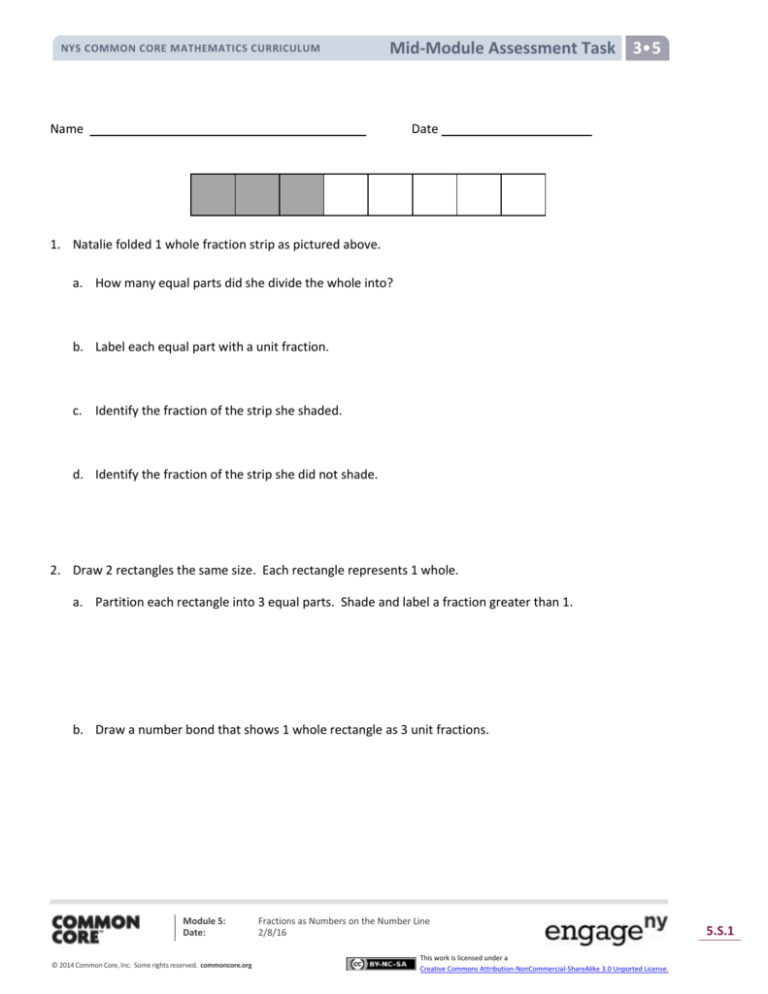
NYS COMMON CORE MATHEMATICS CURRICULUM
3•5
Mid-Module Assessment Task Lesson
2•3
Name
Date
1. Natalie folded 1 whole fraction strip as pictured above.
a. How many equal parts did she divide the whole into?
b. Label each equal part with a unit fraction.
c. Identify the fraction of the strip she shaded.
d. Identify the fraction of the strip she did not shade.
2. Draw 2 rectangles the same size. Each rectangle represents 1 whole.
a. Partition each rectangle into 3 equal parts. Shade and label a fraction greater than 1.
b. Draw a number bond that shows 1 whole rectangle as 3 unit fractions.
Module 5:
Date:
© 2014 Common Core, Inc. Some rights reserved. commoncore.org
Fractions as Numbers on the Number Line
2/8/16
This work is licensed under a
Creative Commons Attribution-NonCommercial-ShareAlike 3.0 Unported License.
5.S.1
3•5
Mid-Module Assessment Task Lesson
2•3
NYS COMMON CORE MATHEMATICS CURRICULUM
New York State Common Core
3. The bakery had a chocolate cake and a vanilla cake that were exactly the same size. Mr. Chu bought 1
fourth of the chocolate cake. Mrs. Ramirez bought 1 sixth of the vanilla cake. Who bought a larger piece
of cake? Explain your answer using words, pictures, and numbers.
3
3
2
4
4. Natalie explained, “My drawing shows a picture of .” Kosmo says, “It looks like a picture of
to me.”
a. Show and explain how they could both be correct by choosing different wholes. Use words, pictures,
and numbers.
b. Natalie said to Kosmo, “One part can represent either 1 half or 1 fourth. That must mean
1
2
=
1
4
.” Do you agree with Natalie? Use words, pictures, and numbers to explain your reasoning.
Module 5:
Date:
© 2014 Common Core, Inc. Some rights reserved. commoncore.org
Fractions as Numbers on the Number Line
2/8/16
This work is licensed under a
Creative Commons Attribution-NonCommercial-ShareAlike 3.0 Unported License.
5.S.2
NYS COMMON CORE MATHEMATICS CURRICULUM
New York State Common Core
3•5
Mid-Module Assessment Task Lesson
2•3
Mid-Module Assessment Task
Standards Addressed
Topics A–C
Develop understanding of fractions as numbers.
3.NF.1
Understand a fraction 1/b as the quantity formed by 1 part when a whole is partitioned
into b equal parts; understand a fraction a/b as the quantity formed by a parts of size 1/b.
3.NF.3
Explain equivalence of fractions in special cases, and compare fractions by reasoning
about their size.
c.
Express whole numbers as fractions, and recognize fractions that are equivalent to
whole numbers. Examples: Express 3 in the form 3 = 3/1; recognize that 6/1 = 6;
locate 4/4 and 1 at the same point of a number line.
d.
Compare two fractions with the same numerator or the same denominator by
reasoning about their size. Recognize that comparisons are valid only when the two
fractions refer to the same whole. Record the results of comparisons with the
symbols >, =, or <, and justify the conclusions, e.g., by using a visual fraction model.
Reason with shapes and their attributes.
3.G.2
Partition shapes into parts with equal areas. Express the area of each part as a unit
fraction of the whole. For example, partition a shape into 4 parts with equal area, and
describe the area of each part as 1/4 of the area of the shape.
Evaluating Student Learning Outcomes
A Progression Toward Mastery is provided to describe steps that illuminate the gradually increasing
understandings that students develop on their way to proficiency. In this chart, this progress is presented
from left (Step 1) to right (Step 4). The learning goal for students is to achieve Step 4 mastery. These steps
are meant to help teachers and students identify and celebrate what the students CAN do now and what they
need to work on next.
Module 5:
Date:
© 2014 Common Core, Inc. Some rights reserved. commoncore.org
Fractions as Numbers on the Number Line
2/8/16
This work is licensed under a
Creative Commons Attribution-NonCommercial-ShareAlike 3.0 Unported License.
5.S.3
NYS COMMON CORE MATHEMATICS CURRICULUM
New York State Common Core
3•5
Mid-Module Assessment Task Lesson
2•3
A Progression Toward Mastery
Assessment
Task Item
and
Standards
Assessed
1
STEP 1
Little evidence of
reasoning without
a correct answer.
STEP 2
Evidence of some
reasoning without
a correct answer.
(1 Point)
(2 Points)
The student has one
answer correct.
The student has two
answers correct.
3.NF.1
STEP 3
Evidence of some
reasoning with a
correct answer or
evidence of solid
reasoning with an
incorrect answer.
(3 Points)
STEP 4
Evidence of solid
reasoning with a
correct answer.
The student answers
Parts (b) through (d)
correctly, but answers
Part (a) with a
fractional answer,
or has answered one of
the four questions
incorrectly or
incompletely.
The student correctly:
(4 Points)
a. Identifies how many
parts the whole is
divided into—8.
b. Labels each unit
1
fraction as .
8
c. Identifies the
3
fraction shaded— .
8
d. Identifies the
fraction
5
unshaded— .
8
2
3.NF.3c
3.G.2
The student is unable
to answer either
question correctly.
The student is unable
to shade a fraction
greater than 1, but
answers Part (b)
correctly.
The student answers
Part (a) correctly, but
does not seem to
understand Part (b).
The student correctly:
a. Shows two
rectangles divided
into thirds with a
fraction greater than
3
shaded.
3
b. Writes a number
bond with the whole
3
1 1
as 1 or , and , ,
1
3
3 3
and as the parts.
3
3
3.NF.3d
3.G.2
The student’s work
shows no evidence of
being able to partition
the cakes into
fractional units to make
sense of the problem.
Module 5:
Date:
© 2014 Common Core, Inc. Some rights reserved. commoncore.org
The student has poorly
represented the cakes,
making it difficult to
compare the fractions.
The student incorrectly
states that Mrs.
Ramirez bought the
larger piece.
The student draws two
equivalent cakes and
realizes Mr. Chu has
the larger piece, but
the explanation is not
clear, perhaps poorly
labeled, lacking a
statement of the
solution.
The student clearly:
Explains that
Mr. Chu bought the
larger piece of cake
using words, pictures,
and numbers.
Fractions as Numbers on the Number Line
2/8/16
This work is licensed under a
Creative Commons Attribution-NonCommercial-ShareAlike 3.0 Unported License.
5.S.4
NYS COMMON CORE MATHEMATICS CURRICULUM
New York State Common Core
3•5
Mid-Module Assessment Task Lesson
2•3
A Progression Toward Mastery
4
3.NF.1
3.NF.3d
3.G.2
The student is unable
to recognize or show
that he or she
recognizes either
fraction in the model.
The student recognizes
3 fourths, but is unable
to recognize 3 halves
within the picture, or
vice versa.
The student is able to
recognize 3 fourths and
3 halves within the
same picture, which is
clear perhaps by
markings on the strip,
but the explanation
lacks clarity.
The student clearly:
a. Uses words,
pictures, and
numbers to explain
how the picture can
be interpreted either
3
as 4 halves with
2
shaded, the whole
being defined by the
middle line of the
strip or as 4 fourths
3
with shaded, with
4
the whole being
defined by the entire
strip.
b. Uses word, pictures,
and numbers to
explain that Natalie
is not correct
because the whole is
different for each
fractional unit.
Module 5:
Date:
© 2014 Common Core, Inc. Some rights reserved. commoncore.org
Fractions as Numbers on the Number Line
2/8/16
This work is licensed under a
Creative Commons Attribution-NonCommercial-ShareAlike 3.0 Unported License.
5.S.5
NYS COMMON CORE MATHEMATICS CURRICULUM
New York State Common Core
Module 5:
Date:
© 2014 Common Core, Inc. Some rights reserved. commoncore.org
3•5
Mid-Module Assessment Task Lesson
2•3
Fractions as Numbers on the Number Line
2/8/16
This work is licensed under a
Creative Commons Attribution-NonCommercial-ShareAlike 3.0 Unported License.
5.S.6
NYS COMMON CORE MATHEMATICS CURRICULUM
New York State Common Core
Module 5:
Date:
© 2014 Common Core, Inc. Some rights reserved. commoncore.org
3•5
Mid-Module Assessment Task Lesson
2•3
Fractions as Numbers on the Number Line
2/8/16
This work is licensed under a
Creative Commons Attribution-NonCommercial-ShareAlike 3.0 Unported License.
5.S.7






